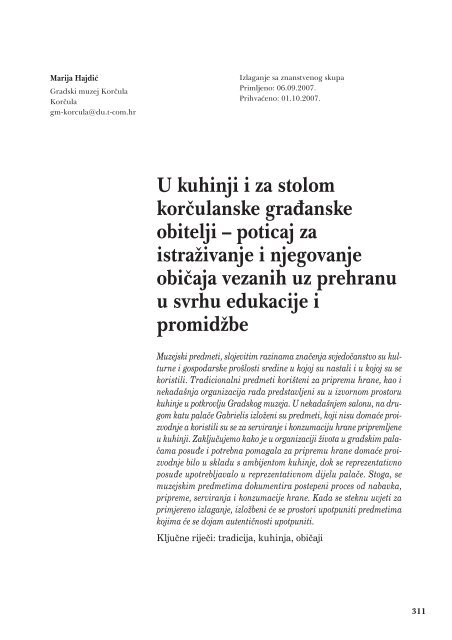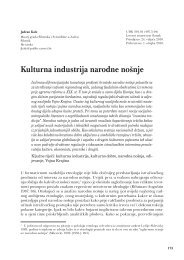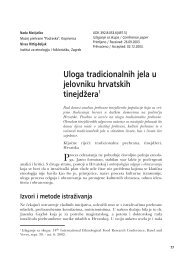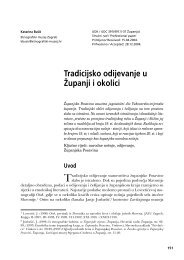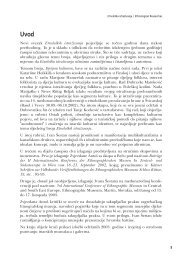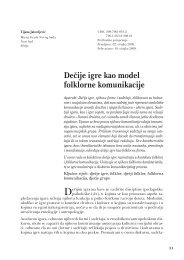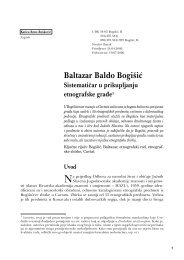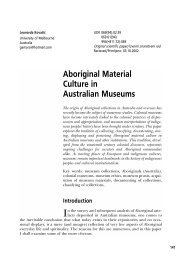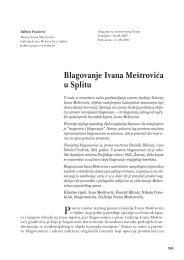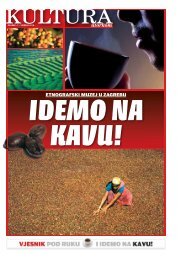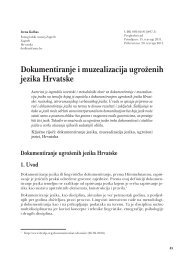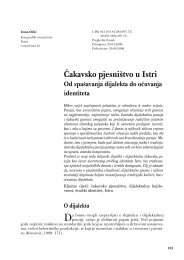U kuhinji i za stolom korÄulanske graÄanske obitelji â poticaj ... - EMZ
U kuhinji i za stolom korÄulanske graÄanske obitelji â poticaj ... - EMZ
U kuhinji i za stolom korÄulanske graÄanske obitelji â poticaj ... - EMZ
You also want an ePaper? Increase the reach of your titles
YUMPU automatically turns print PDFs into web optimized ePapers that Google loves.
Marija Hajdić<br />
Gradski muzej Korčula<br />
Korčula<br />
gm-korcula@du.t-com.hr<br />
Izlaganje sa znanstvenog skupa<br />
Primljeno: 06.09.2007.<br />
Prihvaćeno: 01.10.2007.<br />
U <strong>kuhinji</strong> i <strong>za</strong> <strong>stolom</strong><br />
korčulanske građanske<br />
<strong>obitelji</strong> – <strong>poticaj</strong> <strong>za</strong><br />
istraživanje i njegovanje<br />
običaja ve<strong>za</strong>nih uz prehranu<br />
u svrhu edukacije i<br />
promidžbe<br />
Muzejski predmeti, slojevitim razinama značenja svjedočanstvo su kulturne<br />
i gospodarske prošlosti sredine u kojoj su nastali i u kojoj su se<br />
koristili. Tradicionalni predmeti korišteni <strong>za</strong> pripremu hrane, kao i<br />
nekadašnja organi<strong>za</strong>cija rada predstavljeni su u izvornom prostoru<br />
kuhinje u potkrovlju Gradskog muzeja. U nekadašnjem salonu, na drugom<br />
katu palače Gabrielis izloženi su predmeti, koji nisu domaće proizvodnje<br />
a koristili su se <strong>za</strong> serviranje i konzumaciju hrane pripremljene<br />
u <strong>kuhinji</strong>. Zaključujemo kako je u organi<strong>za</strong>ciji života u gradskim palačama<br />
posuđe i potrebna pomagala <strong>za</strong> pripremu hrane domaće proizvodnje<br />
bilo u skladu s ambijentom kuhinje, dok se reprezentativno<br />
posuđe upotrebljavalo u reprezentativnom dijelu palače. Stoga, se<br />
muzejskim predmetima dokumentira postepeni proces od nabavka,<br />
pripreme, serviranja i konzumacije hrane. Kada se steknu uvjeti <strong>za</strong><br />
primjereno izlaganje, izložbeni će se prostori upotpuniti predmetima<br />
kojima će se dojam autentičnosti upotpuniti.<br />
Ključne riječi: tradicija, kuhinja, običaji<br />
311
Etnološka istraživanja/Ethnological Researches<br />
Izložba vizualnih i audio <strong>za</strong>pisa nastalih bilježenjem događaja<br />
kroz godinu kojih je hrana sastavni dio omogućava<br />
vizuali<strong>za</strong>cija hrane u Gradskom muzeju.<br />
Nadimak „Bonkulović“ povezuje se uz Korčulane – ljubitelje dobre i i<strong>za</strong>brane hrane,<br />
što treba prihvatiti kao jedan od <strong>poticaj</strong>a <strong>za</strong> prikupljanje svih vrsta muzejske građe i<br />
dokumentacije ve<strong>za</strong>ne uz prehranu i njene muzejske prezentacije. Posebno su važni<br />
biljezi koje su sakupili posljednji, još živući stari stanovnici grada Korčule, kao nositelji<br />
kolektivne memorije grada u kojem izumiru sve tradicijske kulturne i povijesne<br />
vrijednosti života. Jedna je od njih Anđelina Goravica koja pamti „cafferteriu šjor Todeta<br />
Pomenića“ u kojoj se prodavao „cukaro de orzo i bruštulane mindole“. Kavana<br />
je neko vrijeme bila u palači Gabrielis – zgradi Gradskog muzeja Korčula. U dnevniku<br />
Edite Ziegler iz 1934. godine <strong>za</strong>pisano je kako je na terasi građanske kuće Kapor<br />
uživala u „nješpulama, grožđu, orahovici i komtonjati (slatkom od dunja)“. U kuharici<br />
u kojoj su <strong>za</strong>pisani recepti Vicenze Depolo Beor s početka 20. stoljeća sačuvan je recept<br />
<strong>za</strong> slatko od dunja (kodnjonjatu), dok se u fundusu Muzeja čuvaju kalupi <strong>za</strong> njegov<br />
pripremu koji su pripadali <strong>obitelji</strong> Šteka. Prenošenje povijesti na mlađe naraštaje<br />
i promicanje tradicije u turističke svrhe moglo bi se ostvariti osposobljavanjem <strong>za</strong>interesiranih<br />
koji bi hranu te raznovrsne voćne likere i rakiju pripremali u replikama<br />
sačuvanog posuđa, a na temelju starih recepata sačuvanih u kuharicama. Na popisu<br />
tih jela svakako bi se trebala naći pašticada od domaćih „njoka“ (valjušaka) i „šuga“<br />
(umaka) od mesa, riba pripremljena na starinske načine te razne vrste tradicionalnih<br />
korčulanskih kolača: klašuna, cukarina, spomilja (poljubaca), hrustula, prikala (uštipaka),<br />
lojenica. U Opatskoj riznici sv. Marka u Korčuli sačuvana je valjkasta drvena<br />
naprava sa spiralnim žljebovima i ručkama, posljednja koja se u Korčuli koristila <strong>za</strong><br />
izradu „cukara de or<strong>za</strong>“ (malih bombona).<br />
Polazeći od termina „cukaro de orzo“ dolazimo do istaknute potrebe bilježenja riječi<br />
(lokali<strong>za</strong>ma) koje su koristile naše „none“, i dio su našeg djetinjstva, a nestaju iz svakodnevnoga<br />
govora. To su: „pasabrod, bronzin, lavadura, škovacjera, kukuma, slatko<br />
od pira, dešpik, la<strong>za</strong>njar, sedita, škancija“. Nakon obilata ručka govorilo se da su<br />
bile „puste pjatance“. Upotreba ovih i drugih lokali<strong>za</strong>ma dovodi do nesporazuma u<br />
komunikaciji s doseljenicima i današnjim naraštajima Korčulana koji koriste standardni<br />
jezik. Riječ „kukuma“ doslovno označuje vrstu posude <strong>za</strong> kuhanje kave, a u prenesenom<br />
smislu osobu koja nije sposobna shvatiti sve ispravno: „Ona ti je prava kukuma!“<br />
Stoga je potrebno bilježiti sva moguća značenja riječi.<br />
Zanimljiva je i uzrečica „Ni jubav juha od hobotnice!“ Naime, voda u kojoj se kuha<br />
hobotnica smatra se beskorisnom te se baca. Za razliku od toga, ljubav je dragocjena<br />
i mora se čuvati.<br />
U staroj <strong>kuhinji</strong> u Gradskom muzeju čuva se drvena naprava <strong>za</strong> oblikovanje tanke duguljaste<br />
tjestenine u obliku špageta. Prema pričanju Srečka Kušurina, nećaka pok.<br />
Antice Cvijić koja je koristila tu spravu, tjestenina se izrađivala kad je bilo burno vrijeme<br />
što je pogodovalo njenom sušenju, dok je južina (šiloko) bila nepovoljna.<br />
312
Marija Hajdić: U <strong>kuhinji</strong> i <strong>za</strong> <strong>stolom</strong> korčulanske građanske <strong>obitelji</strong> – <strong>poticaj</strong> <strong>za</strong> istraživanje i njegovanje<br />
običaja ve<strong>za</strong>nih uz prehranu u svrhu edukacije i promidžbe<br />
U<strong>za</strong> starije građane vezuju se izreke ve<strong>za</strong>ne uz prehranu. Primjerice, šjora Tona je <strong>za</strong><br />
objed, prema svojim mogućnostima, pripremala „dvi salse, malo mesa“ pa je to bio<br />
njezin nadimak. Sve su to elementi iz kojih se iščitavaju brojna značenja koja karakteriziraju<br />
nekadašnji život u Korčuli.<br />
Okupljanja oko stola dio su vjerskih i svjetovnih običaja kroz godinu. Potrebno je prikupljati<br />
dokumentaciju o običajima koji su nestali, njihovim varijantama, kao i onima<br />
koji se danas njeguju.<br />
Na Veliki četvrtak u „palacu“ (nekadašnjem biskupskom dvoru, a danas župnoj kući)<br />
okupljaju se svećenici, dvanaest i<strong>za</strong>branih bratima bratovštine Svih svetih – „učenika“,<br />
kojima svećenik <strong>za</strong> vrijeme obreda pere noge, i gaštaldi – čelnici triju korčulanskih<br />
bratovština. Od hrane, obično se služilo „gorko zeje“ (žutinica), dvije jabuke, vino<br />
te janjetina.<br />
Donedavno, gaštald bratovštine bio je obve<strong>za</strong>n na dan <strong>za</strong>štitnika bratovšine i mali<br />
Uskrs priređivati past (od talijanskog il pasto – obilat ručak) <strong>za</strong> sve članove bratovštine.<br />
Na „vižiju Vodokršća“ (večer uoči Tri kralja) u kući gaštalda bratovštine svake se godine<br />
naizmjence okupljahu svećenici koji su blagoslivljali kuće i „gaštaldi“. Običaj je<br />
izmijenjen pa se okupljanje <strong>za</strong> <strong>stolom</strong> odvija u restoranu. Danas se oko stola članovi<br />
bratovštine redovito okupljaju nakon „procesjuna“ (procesije Velikoga petka), a služe<br />
se „prikle“ (uštipci) i vino, te nakon obreda Velike subote i na dan <strong>za</strong>štitnika bratovštine.<br />
Od svjetovnih običaja hrana je bila uključena u prvomajski uranak te Dan kanjca kada<br />
se sudionici natječu u lovu i pripremi ribe.<br />
Hrana koja se obično konzumirala <strong>za</strong> vrijeme opuštajućeg odlaska na „škoje“ (obližnje<br />
otočiće) <strong>za</strong>bilježena je u pjesmi: “Iz škoja se vraćamo lustrani ko zemlja i od naših<br />
užanci i ovo je jedna. Piraka, kanjaca, lostura i manjaka to je manjaža naših škojara.“<br />
Korčulani su poznati kao ljubitelji „ježina“ (ikre ženke ježinca) koje se izranjaju<br />
i znak su čista mora te priljepaka („lumpara“) koji se „paraju“ (beru) i puževa („grca“)<br />
koji se sakupljaju, a također i školjaka koje se nazivaju „modrujci“.<br />
Na vižiju (od talijanskog avvi<strong>za</strong>re – najaviti) Dana sv. Martina i na sam svečev dan u<br />
Korčuli se kolendava i peče kolač lojenica. Lojenica je <strong>za</strong>bilježena u stihu kolende: „Za<br />
ne povrć <strong>za</strong>kon stari blagovat će i lojenice …“<br />
Na Sv. Barbaru kuha se vara uz pjesmu: „Sv. Barbara obid vari u jednu teču devet<br />
stvari (devet vrsta žitarica).“<br />
Prije nekoliko godina, uz Dan sv. Martina, uvedeno je <strong>za</strong>jedničko okupljanje – degustacija<br />
vina, a priređivala su se i natjecanja u izradi najbolje lojenice.<br />
Stihovi o hrani sastavni su dio stare korčulanske novogodišnje kolende: „One noge<br />
od praščića što su ostale od Božića, boje da ih nami date, nego da ih maška ukrade.<br />
Oj ti slugo od fumara jel ti doma gospodara, darujte nam suha voća da grizemo do<br />
313
Etnološka istraživanja/Ethnological Researches<br />
ponoća. Pasali smo blizu lokve vidili smo stablo od smokve. Dok smo našli vašu kuću,<br />
odrli smo svu obuću. Ode nam je jedan Marin, dodajte mu jedan cukarin.“<br />
Danas se korčulanski karnevalski klub prema tradicionalnom nazivu <strong>za</strong> Korčulane<br />
zove „Bonkulovići“, a jedna je od njihovih akcija u vrijeme karnevala i priređivanje<br />
Pjatanci, odnosno okupljanje maškara uz dobru <strong>za</strong>bavu i domaću hranu koju pripremaju<br />
same maškare, a koja se ocjenjuje i nagrađuje.<br />
Ne<strong>za</strong>obila<strong>za</strong>n su dio prošlosti Korčule i „mlikarice “ iz Žrnova koje se Korčulane opskrbljivale<br />
kozjim mlijekom, noseći ga po kućama. Svaka je obitelj imala svoju „mlikaricu“.<br />
To je <strong>za</strong>bilježeno u pjesmi pastira Mikota: “Žene iz grada, hote do vraga, evo<br />
vam gre Miko, što prodaje mliko.“<br />
Kako su Korčulani u svojim konobama čuvali bačve s vinom, pragovi podrumskih<br />
vrata često su pri sredini <strong>za</strong>obljeni kako bi kroz njih mogla proći bačva s vinom, a<br />
mostovi iznad gradskih ulica, prema korčulanskom statutu, morali su biti podignuti<br />
toliko da ispod njih može proći bačva s vinom. Na taj način hrana, odnosno čuvanje<br />
vina bilo je pove<strong>za</strong>no s urbanizmom i oblikovanjem grada i njegovih ulica te još jednom<br />
pokazivalo međusobnu ovisnost svih aspekata života.<br />
To međusobno preplitanje životnih sfera i dragi običaji ve<strong>za</strong>ni uz prehranu <strong>za</strong>sigurno<br />
će biti vizualno prezentirani u budućem postavu Gradskog muzeja i muzejskoj prezentaciji<br />
stare gradske jezgre, s obzirom da predstavljaju značajan segment korčulanske<br />
svakidašnjice u privatnom i društvenom životu.<br />
Danas je posebnost Gradskog muzeja starinska kuhinja smještena u potkrovlju palače<br />
Gabrielis. Posjetitelju pruža uvid u svakodnevnu pripremu hrane i organi<strong>za</strong>ciju<br />
rada u <strong>kuhinji</strong> – kuhanje, konzumaciju, čišćenje. Uređena je prema muzeološkom<br />
programu Cvita Fiskovića prigodom otvaranja Muzeja 1957., a redovito se popunjava<br />
novim eksponatima koji potječu iz kuća starih korčulanskih <strong>obitelji</strong>. U <strong>kuhinji</strong> se nalazi<br />
otvoreno ognjište (komin) na kojem se kuhalo i oko kojeg su se zimi grijali ukućani<br />
te kameni umivaonik (škafa). Izložen je stol (trpe<strong>za</strong>), katride (stolice), sedita (klupica<br />
s naslonjačem) čije je sjedalo s poklopcem <strong>za</strong>pravo bio sanduk u kojem su se čuvale<br />
namirnice, police i ormar <strong>za</strong> čuvanje posuđa (škancije i kredenca), muškadur <strong>za</strong><br />
čuvanje hrane. Posuđe, domaće proizvodnje, izrađivalo se od bakra (rama). Kuhinja<br />
je opremljena raznovrsnim upotrebljavanim posuđem kao što su „kukume, prsure,<br />
pešijera, bronzini, ražanj“ te pomagalima kao što su „bruštulin i mažinin <strong>za</strong> prženje i<br />
mljevenje kave, rominča <strong>za</strong> hvatanje vode, mortari – avani“. Kalup u obliku janjca <strong>za</strong><br />
uskršnji kolač rijetki je sačuvani predmet ove vrste. Svi ovi predmeti navode se u inventarima<br />
starih korčulanskih kuća pa tako i u popisu pokretne i nepokretne imovine<br />
<strong>obitelji</strong> Donadini s početka 19. stoljeća. S obzirom na to da se u Muzeju čuvaju stare<br />
zbirke recepata <strong>za</strong> pripremanje hrane i proizvodnju vina, kuhinja će se obogatiti<br />
preslikama recepata i fotografijama hrane pripremljene prema tim receptima. Kada<br />
se nakon uređenja Muzeja osiguraju bolji uvjeti izlaganja, kuhinja će se opremiti sadržajima<br />
koji su se nalazili u kuhinjama i spremama kao što je stručak „lumabarajskih<br />
pomidori“ (vrsta manjih rajčica), sušenog bilja <strong>za</strong> čaj – mažurane i popunca, kolačom<br />
(obručom od suhih smokava i lovorike), sušenom lovorikom te bocom „dešpika“<br />
(kvasine s lavandom), pripravkom koji se koristio u slučaju malaksalosti ukućana.<br />
314
Marija Hajdić: U <strong>kuhinji</strong> i <strong>za</strong> <strong>stolom</strong> korčulanske građanske <strong>obitelji</strong> – <strong>poticaj</strong> <strong>za</strong> istraživanje i njegovanje<br />
običaja ve<strong>za</strong>nih uz prehranu u svrhu edukacije i promidžbe<br />
Predstavit će se i tradicionalna okrepa Korčulana – suha smokva u čijoj se sredini nalazi<br />
„mindol“ (badem), a služi se uz „bičerin“ (čašicu) domaće rakije travarice te ušećerene<br />
kore od limuna i naranči.<br />
U kulturno-umjetničkoj zbirci dočaran je svakodnevni život korčulanske građanske<br />
<strong>obitelji</strong>, a posuđe i pribor <strong>za</strong> jelo ističu njeno imovno stanje i status. Svi ovi predmeti,<br />
koji su se nalazili na stolu imućnije <strong>obitelji</strong>, izrađivani su u stranim zemljama. Sačuvano<br />
je nekoliko posuda, tanjura i šalica od ocakljene, šarene majolike iz 18. stoljeća<br />
te velik broj raznovrsna posuđa od ocakljene keramike s otisnutim uzorcima, proizvedena<br />
u manufakturama Cardiffa u 19. stoljeću, kao što su tanjuri, plitice, servisi<br />
<strong>za</strong> jelo, čajnici, šalice, vrčevi. To su posuđe kupovali korčulanski pomorci, a početkom<br />
20. stoljeća preprodavali putujući trgovci pa se tako našlo u velikom broju korčulanskih<br />
kuća. Nekoliko komada posuđa japanske je proizvodnje. Sačuvan je velik<br />
broj staklenih čaša te boca iz <strong>obitelji</strong> Boschi i Dimitri iz 18.-19. stoljeća često s inicijalima<br />
vlasnika. Pribor <strong>za</strong> jelo redovito se spominje u ispravama. U skromnijim kućama<br />
upotrebljavao se limeni, a imućniji su posjedovali i srebrni. S obzirom na to da<br />
se u oporukama i popisima mira<strong>za</strong> navode po jedan, dva ili najviše tri komada srebrnog<br />
pribora <strong>za</strong> jelo koji se nekome ostavljaju ili daruju, može se <strong>za</strong>ključiti da su ti<br />
predmeti smatrani dragocjenima.<br />
To više daje na značenju srebrnom priboru <strong>za</strong> jelo venecijanske proizvodnje s ugraviranim<br />
inicijalima vlasnika i signaturom njihova tvorca od kojeg su sačuvani po dva ili<br />
tri komada iz kompleta. Znanje o korčulanskoj svakodnevici upotpunjeno je primjercima<br />
pribora <strong>za</strong> jelo s drškama od bjelokosti iz <strong>obitelji</strong> Fabris-Zanon te dokumentima<br />
koji govore o izradi srebrnog i zlatnog pribora <strong>za</strong> jelo u korčulanskim zlatarskim radionicama<br />
19. stoljeća – Stefana Calogjere i Artura Marinovića. Trgovanje, pomorstvo,<br />
izvoz kamena i rad korčulanskih brodograditelja izvan Korčule omogućivali su<br />
Korčulanima upoznavanje s načinom života dalekih zemalja pa se tako u kući Bochi<br />
upotrebljavao ruski samovar koji se danas nalazi u fundusu Muzeja.<br />
Mjedeni pladnjevi s ugraviranim natpisima i ukrasima iz 17. stoljeća koji su služili <strong>za</strong><br />
posluživanje hrane <strong>za</strong> veći broj ljudi te reprezentativni primjerci mužara (avana) <strong>za</strong><br />
usitnjavanje namirnica i stolnjaci s kraja 19. stoljeća govore o kulturi svakodnevnog<br />
života. Hrana je njegov sastavni dio što zorno prikazuje velik broj eksponata koji su<br />
se koristili <strong>za</strong> pripremu i konzumaciju hrane, a izlagali su se u građanskim salonima,<br />
što se njihovom prezentacijom u Gradskom muzeju nastoji ostvariti i danas.<br />
Literatura<br />
Fazinić, A. (2004) Neki podaci o privatnom životu u gradu Korčuli od XVI. do XIX<br />
stoljeća, u: Godišnjak Grada Korčule 9, Korčula, str. 67-109<br />
Bernardi Breece, J. (1996) My grandmothers recipies, rukopis<br />
Ziegler, E. (1937), Tagebuch – dnevnik, rukopis<br />
315
Etnološka istraživanja/Ethnological Researches<br />
8.01 8.02<br />
316
Marija Hajdić<br />
Gradski muzej Korčula<br />
Korčula<br />
gm-korcula@du.t-com.hr<br />
Conference paper<br />
Received: September 06, 2007.<br />
Accepted: October 01, 2007.<br />
In the Kitchen and at the<br />
Table of an Urban Family<br />
in Korčula – an Incentive<br />
for the Research and<br />
Preservation of Nutrition<br />
Customs<br />
Museum items testify with their layered significance to the cultural and<br />
economic past of the environment where they were created and utilized.<br />
Traditional items used for the preparation of food as well as the<br />
organi<strong>za</strong>tion of work of those times are presented in an authentic kitchen<br />
room in the attic of the Municipal Museum. In the salon of those<br />
times, on the second floor of the Gabrielis palace there is an exhibit of<br />
the imported items used to serve and consume food prepared in the kitchen.<br />
It can be assumed that life in the palaces of the city was organized<br />
in such way that the dishes and the cutlery produced locally matched<br />
the kitchen ambient, while representative items were used in the representative<br />
part of the palace. Thus, the whole process from the purchase<br />
to the preparation, serving and consumption of food is documented by<br />
the museum exhibits. When the conditions for an adequate exhibition<br />
of the items are met, the exhibition rooms will be made complete with<br />
items that will furnish the impression of authenticity.<br />
Key words: Tradition, kitchen, custom<br />
T<br />
he exhibition of multimedia records created by recording<br />
the food-related events through the year will make<br />
the visuali<strong>za</strong>tion of food possible in the Municipal Museum.<br />
317
Etnološka istraživanja/Ethnological Researches<br />
The nickname „Bonkulović“ is used to term the Korčula islanders as admirers of<br />
good and chosen food, which should be accepted as an incentive to collect all kinds<br />
of museum inventory and documentation related to food and to present it in a museum<br />
exhibition. The memories of the senior citizens of Korčula are especially important,<br />
as they are the preservers of the city’s collective memory with whose fading<br />
all the traditional cultural and historical values of life fade. One of them is Anđelina<br />
Goravica who remembers the cafeteria of šjor Tode Pomenić where cukaro de orzo and<br />
bruštulani mindoli were sold. The coffee house was at one time situated in the Gabrielis<br />
palace – where the Museum is located today. In Edita Ziegler’s diary dated in 1934<br />
she records that she enjoyed nješpule, grapes, walnut brandy and kodonjati (quince jelly)<br />
on the terrace of the Kapollo villa. In Vicen<strong>za</strong> Depolo Beor’s cookbook a recipe for<br />
quince jelly (kodonjata) is preserved, while the molds for its preparation, once owned<br />
by the Šteka family, are kept as a part of the museum’s inventory. Bequeathing history<br />
to younger generations and promoting tradition to further tourism is brought to reali<strong>za</strong>tion<br />
by training those involved and interested who could prepare food and various<br />
fruit liquors in the replicas of the preserved traditional dishes, following the preserved<br />
old recipes. On the list of dishes one should surely have pašticada with homemade<br />
gnocchi and meat sauce (šug), fish prepared in traditional ways and different<br />
kinds of traditional korčula cakes: klašuni, cukarini, spomilje (i. e. kisses), hrustule, prikle<br />
(donuts), lojenice. The last preserved cylindrical appliance with spiral rifles and with<br />
handles which was used to prepare cukari di orzi (small candy) is kept in the St. Marcus<br />
Abbey’s vault. Starting with the term cukari di orzi, we arrive to the existence of<br />
the need to record the localisms, words once by our ‘grannies’ which belong to our<br />
childhood, and fade out from everyday speech. These are: pasabrod, bronzin, lavadura,<br />
škovacjera, kukuma, slatko od pira, dešpik, la<strong>za</strong>njar, sedita, škancija. After a heavy<br />
lunch people would say puste pjatance (cleaned plates). The use of this one, and other<br />
localisms causes misunderstanding in everyday communication with the migrants<br />
and today’s generations of Korčulans, who use the standardized dialect. The word<br />
kukuma has an additional metaphoric meaning besides meaning a coffee pot, meaning<br />
a kind of person who is not capable of getting everything correctly: She’s a real<br />
kukuma! He nickname bruštulin is also common, also derived from an appliance used<br />
to bake coffee while manjamukte is used to describe persons who have a habit of inviting<br />
themselves to free meals – or persons unable to perform duties they were assigned<br />
to. With the proverb ‘eyeing meat, forking a potato’ one denotes a person who<br />
is confused and momentarily can’t follow what is happening around her. Therefore<br />
it is necessary to record all the meanings the words possess.<br />
The saying ‘Love is not octopus soup’ is also interesting. It is because the water left<br />
after boiling an octopus is considered useless and thrown away. Unlike that, love is<br />
precious and has to be kept.<br />
A wooden appliance used to make elongated thin pastry like spaghetti, is kept in the<br />
old kitchen in the Municipal Museum. According to Srečko Kušurin, nephew of the<br />
late Antica Cvijić who used to use the appliance, the pastry was made when the wind<br />
blew from the north (bora) which would hasten drying, while the južina (šiloko/scirocco)<br />
would work against it.<br />
318
Marija Hajdić: In the kitchen and at the table of an urban family in Korčula – an incentive for the research<br />
and preservation of nutrition customs<br />
There are some sayings on the topic of eating associated with older citizens. An example<br />
is šjora Tona who would prepare a double salsa and some meat whenever she could,<br />
which eventually turned into her nickname. These expressions carry the notions of<br />
the older way of life in Korčula.<br />
Gatherings around the table formed a part of the religious and nonreligious customs<br />
during the year. It is necessary to collect records of these faded customs, their varieties,<br />
as well as those customs still followed today.<br />
On Holy Thursday the priests would gather in the palace (the parish house) and the<br />
twelve elected high brothers of the All Saints fraternity – the ‘disciples’ whose feet<br />
would be washed by a priest, and the gaštaldi – the heads of the three civil fraternities<br />
of Korčula. The usual menu would consist of horseradish, two apples, vine and a<br />
spring lamb roast. In the still recent past a head of the fraternity would have to prepare<br />
a past (from Italian pasto, meaning a rich lunch) for all the members of the fraternity.<br />
Priests who would perform blessings of the homes would meet at the „vižija<br />
Vodokršća“ (the night before Epiphany) in the house of the head of a fraternity every<br />
other year, and the heads would meet in the years between. The custom was changed<br />
so these days the gatherings take place at a restaurant.<br />
In these times the members of a fraternity meet regularly after the procesjun (the Good<br />
Friday procession around the city center) when prikle (pinches) and wine are served,<br />
and after the procession ‘over the hills’ in the early hours of Holy Saturday. Considering<br />
that the members of the fraternity of St. Rok take a special part in the evening<br />
service on Holy Saturday, with a short procession in the cathedral carrying a statue of<br />
the Resurrected Christ (Redentur), which is called Gloria, they meet after that service<br />
in the hall of the house of their fraternity. All the fraternities organize luncheons<br />
on their patron saints’ days.<br />
After the closure of the religious service on the occasions of celebrating various events<br />
and anniversaries, there would be a tratamenat (treating). The inhabitants of Korčula<br />
and their guests would treat themselves with various small homemade cakes, juice and<br />
wine. One of these treatings held after the First Mass of the last Abbot of Korčula, Don<br />
Ivo Matijaca stands recorded in the diary of events kept by Antun Glavočić.<br />
Some of the nonreligious festivities which involved food preparation were the wake<br />
on the eve of May Day and the Day of the kanjac in July, when those taking part in it<br />
would compete in fishing and preparation of the fish.<br />
The usual food which would be eaten during the relaxing sailing towards the škoji (the<br />
nearby islets in the Korčula archipelago) was recorded in the poem: Iz škoja se vraćamo<br />
lustrani ko zemlja i od naših užanci i ovo je jedna. Piraka, kanjaca, lostura i manjaka to je<br />
manjaža naših škojara. The inhabitants of Korčula are known to enjoy the ježina (roe<br />
of the female sea urchin) which is harvested out of the sea and whose presence shows<br />
there are no pollutants in the sea, and the priljepci (lumpari) which are picked, the sea<br />
snails grci which are collected and a species of shellfish called modrujci. While a knife<br />
is needed to pick shellfish attached to the rocks, a special tool, ‘ ježinjak’ is used to harvest<br />
urchins, and their roe is always eaten with bread and high quality red wine.<br />
319
Etnološka istraživanja/Ethnological Researches<br />
On the vižija (from the Italian avvi<strong>za</strong>re – to announce) of St Martin and on the saint’s<br />
day people wassail and the lojenica cake is baked. Lojenica is recorded in the carol:<br />
„Za ne povrć <strong>za</strong>kon stari blagovat će i lojenice …<br />
On St Barbara’s day a cereal meal is cooked, with the song: St Barbara cooks a meal with<br />
nine things (kind of cereal).<br />
A few years ago, on St Martin’s day, a common gathering was introduced – to taste<br />
wines, and there were also competitions in making lojenica.<br />
Verses about food are integral parts of the old Korčula New Year’s carol: Those pig<br />
legs left over from Christmas, you better give to us than let the cat take them. Oh you<br />
home servant, is your master at home, give us some dried fruit to eat them till midnight.<br />
We passed by a pond and saw a fig tree. We tore our shoes by the time we found<br />
your house. We have a Marin here, give him a cukarin.<br />
These days the Korčula carnival club is called Bonkulovići, coming from a traditional<br />
nickname for the inhabitants of Korčula, and one of their activities during the carnival<br />
is to arrange pjatanci, a gathering of masked revelers with good entertainment and<br />
food prepared by the revelers themselves, which is then judged and rewarded.<br />
An unavoidable part of Korčula’s past were also the milk ladies form the nearby village<br />
of Žrnovo who supplied the Korčula townspeople with goat milk which they distributed<br />
to their houses, so that every house had its own milk lady. This was recorded<br />
in the song of the shepherd Mikota: Woman from the town, go to the devil, here<br />
comes Miko who sells you milk.<br />
As the Korčula townspeople stored their wine barrels in the wine lodges, the doorsteps<br />
of wine cellars were often rounded in the middle, so that a wine barrel could pass<br />
through the door, while the crossovers over the town streets, had to be high enough<br />
for a wine barrel to pass through, as mandated by the town statute. This way the food<br />
and the preservation of foodstuffs were connected with urbanism and urban design,<br />
which once more shows the interaction of all aspects of life.<br />
This interweaving of the spheres of life and other customs related with food will surely<br />
be presented in the future outlook of the Municipal Museum and the museological<br />
presentation of the old town center, considering the fact that they represent a significant<br />
segment of everyday life in Korčula, both personal and public.<br />
A special feature of the Municipal Museum is the old kitchen in the attic of the Gabrielis<br />
palace. It offers to its visitors an insight into the everyday preparation of food<br />
and the organi<strong>za</strong>tion of work in the kitchen – cooking, eating, and cleaning. It was arranged<br />
according to the museological program created by Cvito Visković, PhD around<br />
the opening of the Museum in 1957, while items originating from the old Korčula family<br />
houses are still being regularly collected. There is an open fireplace in the kitchen<br />
called komin where food was cooked and which was used for heating in the winter,<br />
and a lavatory made of stone called škafa. A table trpe<strong>za</strong>, katride (chairs) and a sedita<br />
(a bench with a backseat) which was also a crate used to store food; also, shelves and<br />
320
Marija Hajdić: In the kitchen and at the table of an urban family in Korčula – an incentive for the research<br />
and preservation of nutrition customs<br />
a cupboard (škancije i kredenca) and a muškadur used to keep food. The dishes, which<br />
were homemade, were made of copper (ram). The kitchen has various dishes, like kukume,<br />
prsure, pešijera, bronzini, ražan, utensils like bruštulin i mažinin (used to grind and<br />
bake coffee), rominča to draw water, mortari-avan to grind sugar. A mold in the shape<br />
of a lamb used for the Easter cake is a rare surviving specimen of this item. When<br />
this cake would be baked and after it’s cooled down, it would be speckled with powdered<br />
sugar, to look as much as possible as the thing it represents. Coffee beans serve<br />
to represent its eyes. All these items are listed in the inventories of the old Korčula<br />
family houses, and also in the lists of the assets of the Donadini family in the early<br />
19 th century. Taking into account the fact that Museum keeps old collections of recipes<br />
to prepare food and produce wines, the kitchen exhibit will be enriched with the<br />
copies of its recipes and the food prepared following those recipes. When better conditions<br />
for exhibitions are ensured, after the renovation of the Museum, the kitchen<br />
will be furnished with the artifacts that would be found in the kitchens and larders<br />
like a bunch of lumabarajski pomidori (a kind of smaller tomatoes usually put into<br />
soup), dried herbs for teas (mažurane, metvice i popunca), kolač (a string ring of dried<br />
figs and lavender), dried lavender and a bottle of dešpik (vinegar with lavender), a medicament<br />
used if an inhabitant felt faint.<br />
A traditional refreshment of the Korčula inhabitants will also be presented – a dried<br />
fig in whose center a mindol (almond) is put, which is served with a small glass (bičerin)<br />
of homemade herb brandy and sugared lemon and orange rind. Dekot will also be<br />
exhibited, a medicament made of cooked dry figs, ground almonds in the crust and<br />
pieces of dried carob and sugar used when someone has a cold.<br />
In the cultural and artistic the everyday life of an urban Korčula family is exposed,<br />
while its dishes and crockery show their wealth and status. All of these items, who<br />
would find their place on a table of a wealthy family, were imported from abroad. A<br />
few dishes were preserved, plates and cups of glazed colored maiolica from the 18 h<br />
century and a great number of various glazed ceramic dishes with printed patterns,<br />
made in the Cardiff manufactures in the 19 th century, like plates, eating sets, teapots,<br />
cups and jugs. This crockery was acquired by the sailors from Korčula, and in the 20 th<br />
century it was resold by traveling salesmen and was thus found in many Korčula houses.<br />
A few pieces are of Japanese origin. A great number of glasses and bottles owned<br />
by families Boschi and Dimitri in the 18 th and 19 th centuries were also found, often<br />
with engraved initials of their owners. Eating utensils are also regularly mentioned<br />
in documents. In the less affluent houses it was made of iron while the wealthier had<br />
silverware. When the fact that in the testaments and in dowry documents only one,<br />
two or at most three pieces of silverware were listed is taken into account, it is obvious<br />
that they were considered very valuable.<br />
This emphasizes even more the silverware made in Venice with the engraved initials of<br />
their makers of which a couple of pieces from the set were preserved. The knowledge<br />
about everyday life in Korčula is complemented with a few pieces of eating utensils<br />
with ivory handles owned by the Fabris-Zanon family and the documents which concern<br />
the manufacture of silverware and golden ware in the Korčula gold workshops<br />
321
Etnološka istraživanja/Ethnological Researches<br />
of the 19 th century - Stefana Calogjera i Artura Marinović. Trading, sailing the export<br />
of stone and the work of Korčula shipbuilders further away from Korčula made<br />
the knowledge about other cultures and lifestyles possible for Korčula, so for example<br />
one could find a Russian samovar in the Boschi family home. Today it is in the<br />
possession of the Museum.<br />
Brass plates with engraved writings and ornaments from the 17 th century which were<br />
used to serve food to a larger number of people and the representative items of mužar<br />
(avan), used to grind food, and the tablecloths from the end of the 19 th century represent<br />
the culture of everyday life. Food is its integral part which is evidently shown<br />
by a large number of items used to prepare as well as those used to consume food.<br />
They were exhibited in the urban salons jus as we are trying to present them in the<br />
Municipal Museum today.<br />
Finally, it can be concluded that the visuali<strong>za</strong>tion of food could be realized in the near<br />
future with an exhibition of visual and audio recordings made while recording events<br />
during the year of which food is an integral part.<br />
Translated by Tomislav Ređep<br />
322


